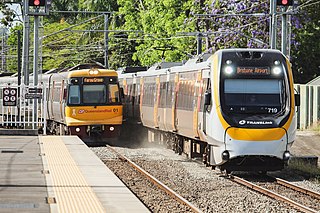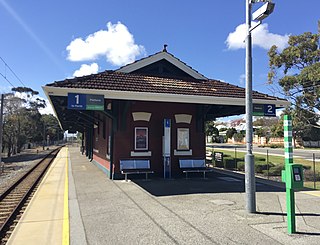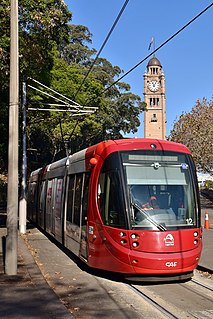
CountryLink was a passenger rail and road service brand that operated in regional areas New South Wales, Canberra, Brisbane and Melbourne. Originally created as a business unit of the State Rail Authority of New South Wales, it later became a subsidiary of RailCorp, a Government of New South Wales entity. CountryLink operated rail services using XPT and Xplorer rolling stock, with connecting coach services operated under contract by private operators.

Rail transport in Australia is a component of the Australian transport system. It is to a large extent state-based, as each state largely has its own operations, with the interstate network being developed ever since federation. As of 2019, the Australian rail network consists of a total of 32,894 kilometres (20,439 mi) of track built to three major track gauges: 17,972 kilometres (11,167 mi) of standard gauge ), 2,683 kilometres (1,667 mi) of broad gauge, and 11,930 kilometres (7,410 mi) of narrow gauge lines. Additionally, about 1,400 kilometres (870 mi) of 610 mm / 2 ft gauge lines support the sugar-cane industry.

The rail network in Adelaide, South Australia, consists of six lines and 89 stations, totalling 132 km. It is operated by Keolis Downer under contract from the Government of South Australia, and is part of the citywide Adelaide Metro public transport system.
The Armadale line is a suburban rail service in Western Australia that runs from Perth to Armadale on the South Western Railway. This service is planned to extend to the suburb of Byford over an 8-kilometre-long (5.0 mi) new railway line constructed as part of the Byford Rail Extension project.
The Fremantle line is a suburban railway and service in Western Australia that connects the central business district (CBD) of Perth with Fremantle.

The Joondalup line is a commuter rail service in Western Australia, linking the Perth central business district (CBD) with the metropolitan area's north-western suburbs. The service is operated on the Northern Suburbs Railway by Transperth Train Operations, a division of the Public Transport Authority, and is part of the Transperth network. It is 40.7 kilometres (25.3 mi) long and serves 13 stations. The service is currently, as of 2022, being extended to Yanchep as part of the Yanchep Rail Extension project, and may be renamed once the extension to Yanchep is completed.

Perth railway station is the largest station on the Transperth network, serving the central business district of Perth, Western Australia. It serves as an interchange between the Armadale, Fremantle, Joondalup, Mandurah and Midland lines as well as Transwa's Australind service.
The State Rail Authority, a former statutory authority of the Government of New South Wales, was responsible for the operation and maintenance of railways in the Australian state of New South Wales from July 1980 until December 2003.

Daglish railway station is a commuter railway station on the boundary of Daglish and Subiaco, suburbs of Perth, Western Australia. The station is on the Fremantle railway line, which is part of the Transperth public transport network. It has an island platform, accessed by a pedestrian underpass. The station is only partially accessible due to a steep ramp and lack of tactile paving. Services run every 10 minutes during peak, and every 15 minutes outside peak, and on weekends and public holidays. The journey to Perth railway station is 4.9 kilometres (3.0 mi), and takes 7 minutes.

Fremantle railway station is the terminus of Transperth's Fremantle line in Western Australia.

Cottesloe railway station is a railway station on the Transperth network. It is located on the Fremantle line, 12.4 kilometres from Perth station serving the suburbs of Cottesloe and Peppermint Grove.
Western Australian Government Railways (WAGR) was the operator of railway services in the state of Western Australia between October 1890 and June 2003. Owned by the state government, it was renamed a number of times to reflect extra responsibility for tram and ferry operations that it assumed and later relinquished. Its freight operations were privatised in December 2000 with the remaining passenger operations transferred to the Public Transport Authority in July 2003.
Railways in Western Australia were developed in the 19th century both by the Government of Western Australia and a number of private companies. Today passenger rail services are controlled by the Public Transport Authority through Transperth, which operates public transport in Perth, and Transwa, which operates country passenger services. Great Southern Rail operates the Indian Pacific.
The Northern Suburbs Transit System is the name given to the project initiated and funded by the Government of Western Australia to provide high-speed passenger rail services to the northern corridor of metropolitan Perth, the capital city of Western Australia. The project was commenced by the Dowding Labor government in the late 1980s, and its main feature project was the Joondalup railway line and linked bus services, which have been a core component of the Transperth transport network since the line's opening to passengers on 21 March 1993.

The Newcastle railway line is a branch railway line in the city of Newcastle, New South Wales, Australia. The line branches off the Main North line at Broadmeadow and travels in an easterly direction through the inner suburbs to Newcastle Interchange, with one intermediate station at Hamilton. Until its curtailment in December 2014, it extended to Newcastle station. NSW TrainLink operates electric passenger train services over this line as part of its Central Coast & Newcastle Line service, and diesel railcars to Maitland and beyond as part of the Hunter Line.

The earliest trams in Australia operated in the latter decades of the 19th century, hauled by horses or "steam tram motors". At the turn of the 20th century, propulsion almost universally turned to electrification, although cable trams lingered in Melbourne. In cities and towns that had trams, they were a major part of public transport assets.

Transperth Train Operations is a division of the Public Transport Authority of Western Australia. It is responsible for operating Perth’s urban passenger rail system, as part of the Transperth network.
Transperth is the brand name of the public transport system serving the city and suburban areas of Perth, the state capital of Western Australia. It is operated by the Public Transport Authority.
Perth City Link is an urban renewal and redevelopment project in Perth, Western Australia.

The 1970 Corridor Plan for Perth provided a strategic framework for planning the growth of the metropolitan region of Perth, Western Australia. The Plan superseded the 1955 Plan for the Metropolitan Region and established the principles on which the Metropolitan Regional Planning Authority would consider amendments to the Metropolitan Region Scheme. In contrast to the earlier plan, the Corridor Plan was not a detailed spatial plan of the entire metropolitan area. Instead it was intended to provide a framework for the detailed structure planning of each of the four proposed corridors. A review of the plan was completed in 1987, followed by the preparation and adoption of the 1990 Metroplan.













